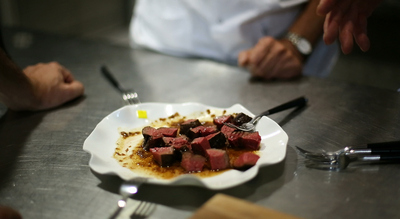 I will say this about Steak (R)evolution — once you watch this documentary, you will know just about everything you ever wanted to know about steak, even if you love steak so much you wish you had a meat locker in your home. I say that as a man who appreciates a damn good steak, no matter what the price. At 110 minutes, it’s the longest documentary I’ve seen at Tribeca this year by 20 minutes. That means the subject of beef is covered in intricate detail. Of course, being thorough doesn’t always make for a great presentation, so while Steak (R)evolution is full of juicy bits of beef, it’s also kept on the grill a little too long.
I will say this about Steak (R)evolution — once you watch this documentary, you will know just about everything you ever wanted to know about steak, even if you love steak so much you wish you had a meat locker in your home. I say that as a man who appreciates a damn good steak, no matter what the price. At 110 minutes, it’s the longest documentary I’ve seen at Tribeca this year by 20 minutes. That means the subject of beef is covered in intricate detail. Of course, being thorough doesn’t always make for a great presentation, so while Steak (R)evolution is full of juicy bits of beef, it’s also kept on the grill a little too long.
Director Franck Ribiere comes from a family of French cattle breeders and always thought of French beef as the best in the world. After all, the French know a thing or two about cooking, right? That is until Ribiere had a “highly unusual” steak at Peter Luger’s in Brooklyn, New York that he describes as the “best steak in the world.” He soon realized that as much as the French are experts in cheese and wine, they’re a bit behind the curve on beef. Returning to Paris, he meets a butcher who agrees with his assessment of French beef who explains how French breeding methods produce cattle with little fat — which means it isn’t suitable for grilling. Ribiere then decided to find the actual best steak in the world and filmed the journey as a documentary.
Steak (R)evolution takes the viewer to Argentina, Brooklyn, Montreal, England, Scotland, Japan, Sweden, Italy, and Spain to speak to breeders, butchers, and chefs about what makes the best steak. Naturally, there are disagreements on how climate, diet, cattle age and even seemingly minor details (such as the Japanese breeder who plays classical music for his cows) affect the quality of the beef. Ribiere serves as the impartial judge, and what he picks as the best steak in the world will probably surprise you considering what is commonly believed about the steaks we eat.
Still, Steak (R)evolution moves at a snail’s pace. It includes long, ponderous shots of the cattle sometimes gives the film the feeling of a nature movie. The fact that a viewer has to stare at delicious steak they cannot taste makes the movie seem that much longer (I was starving for a steakhouse not even fifteen minutes into watching). I actually think this material would’ve worked better in a longer format as a television mini-series because covering so many locations — even in 110 minutes — means that each segment seems to cover just the basics of each method of breeding or cooking. For example, there is an extremely interesting segment with a French breeder named Berenice, who is a young woman in what is a male-dominated industry — but the documentary doesn’t spend much time with her. So as odd as that sounds, Steak (R)evolution is both overlong yet too short — that’s because it just seems to be in the wrong format.
There is also an undercurrent of eco-responsibility in the documentary, particularly in the American segment. Beef requires many resources to produce, and there is a significant push for a return to grass-fed beef over the last two decades. Again, had this documentary been presented in a more effective format, more could’ve been explored on this topic.
Steak (R)evolution is a solid documentary, but it’s really not a “theater” documentary. The last place you want to be to watch this is sitting in a movie theater munching on popcorn. Wait for it to come on TV or DVD, and then watch it as you prepare a nice, thick steak. It’s probably the best way to enjoy this delicious journey.

















Recent Comments